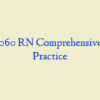Description
NURS 301 Health Assessment Exam 1 Focus Topics to Review – Nevada State College
Exam 1 will cover Chapters 1 to 5, Chapters 8, 9, 13, 14, 19, 23 Exam Items: 50 multiple choice, True or False
- Explain the purpose of a nursing health assessment
- Compare and contrast medical assessment from nursing health assessment.
- Describe the phases of the nursing process involved in health assessment by the nurse.
- Compare and contrast the four basic types of nursing assessment: (a) initial comprehensive, (b) ongoing or partial, (c)focused/problem oriented, (d) emergency.
- Compare and contrast subjective from objective data
- Describe the three phases of a client interview process. Give examples on what occurs in each phase.
- Describe effective verbal and nonverbal communication techniques to collect subjective client data.
- Identify verbal communication to avoid during a client interview
- Describe ways to adapt the interview for the olderclient.
- Describe the purpose of performing genogram.
- Summarize the ways that the nurse can prepare the client for a physical examination
- Explain the 4 physical assessment techniques and sequence of physical assessment.
- Describe ways to validate data
- Explain the purposes of documenting assessmentdata
- Explain the purposes of documenting assessmentdata
- Describe the seven distinct steps used to perform data analysis
- Compare and contrast Health Promotion, Risk, Actual and Collaborative Diagnoses
- Identify safe guidelines for documentation of client data
- What is SBAR?
- Describe how to perform the general status assessment.
- Compare and contrast normal from abnormal findings.
- Explain the significance of the abnormal findings.
- Discuss the assessment of pain as a fifth vital sign.
- How is pain assessed?
- What is COLDSPA?
- When does the nurse perform a pain assessment?
- Describe findings often seen when assessing an older client’s general health status and vital signs.
- Identify the pain assessment tools that is best for children and older adults
- Discuss the measures/ways to reduce these risk factors
- Discuss how to teach a client to perform a self-assessment of the skin, hair, and nails.
- Identify the risk factors for lung cancer and ways to reduce these risk factors
- Describe how to perform abdominal and thorax and lungs assessment.
- Explain the correctsequenceandtechniquesofphysicalassessmentwhenperformingabdominal and thorax and lungsassessment
- Discuss common skin, hair and nails abnormal findings and its significance.
- Discuss the rationale for questions when collecting subjective data in the abdominal and thorax and lung assessments.
- Compare and contrast expected normal findings from abnormal assessment findings in abdominal and thorax and lungs assessment.
- Explain the significance of abnormal findings in abdominal and thorax and lungs assessment
- Describe the age-related changes of the skin, hair and nails, abdomen and thorax and lungs
- Explain the purpose of nutritional status assessment. nurs 301
- Explain the significance of BMI, MAC and waist circumference measurements.



